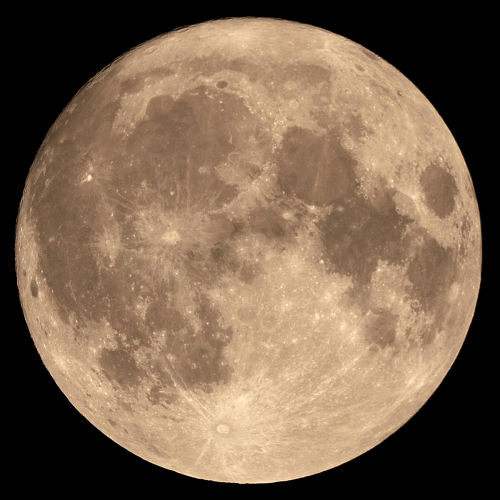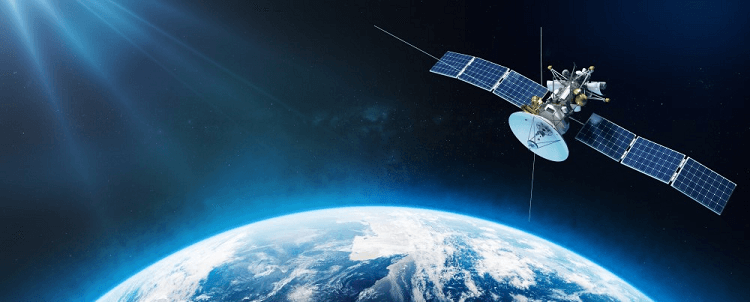Satellite DefinitionWe all are very familiar with the word satellite; almost every person, irrespective of his field and educational qualification, might have listened to this word satellite. This article will discuss satellites that are both "Manmade" and "Natural Satellites." Some readers might feel slightly awkward after reading the word "Natural Satellite" Let us first show a glimpse of Natural and Manmade Satellite. Natural Satellites are those satellites that occur naturally, and there is no such need for maintenance or refueling; they take care of themselves; like Moon is the only natural satellite of Earth, there are many other planets that have no natural satellites, and some have more than two natural satellites like Saturn and Jupiter. 
Manmade Satellites are those which are artificially sent into the Earth's orbit, and they need time to time proper maintenance, refilling, and many other things; Artificial Satellites are very beneficial for us as they play a vital role in providing us with various information; a few Artificial Satellites are Sputnik 1, Apple and many more. Now we will thoroughly discuss both types of Satellites, 1. Artificial or Artificial SatellitesIt is an artificial satellite that is intentionally put into the Earth's orbit to move and revolve around the planet. When a Satellite revolves around a planet, it provides various necessary details and instructions like weather forecasting (predicting the nature of weather), Communicational relays, Scientific Research, Broadcasting, Earth Observation, and GPS Navigation also for various military purposes. Satellites play a vital role in enhancing our knowledge regarding Cosmos, and it has also indicated to us that we are not the only living being in this Universe. Moreover, they helped in understanding the nature of various celestial bodies. Artificial Manmade satellites helped predict the risks we are getting from Space, like the clashing of meteors, space sand, and space dust. Artificial satellites also helped us understand Earth's outer atmosphere, knowing that, now, we have placed our various powerful telescopes in the outer region of Earth, which help us discover things that are a million times far away from us. 
How are Satellites Launched? Artificial Satellites are launched into the external atmosphere using rocket launchers and launch pads. A Satellite is a small-sized box compared to the rocket's other parts. After successfully crossing the Earth's gravitational pull or force (the force with which Earth attracts objects towards it), when the rocket reaches outer Space or the outer orbit of the Earth then, it launches the satellite into the Earth's orbit so that it can rotate in orbit and can provide useful instructions. When a satellite is launched, it has flaps or wings like a thing that helps it to charge its battery continuously so that it can move according to its will and if scientists want to move the satellite into the outer orbit of some other planet even then it uses its wing like structure to move to that planet's orbit. First Artificial Manmade Satellite If we discuss the first Artificial Manmade Satellite in the world, then it was the USA (United Nations of America) that declared in the year 1955 that they were starting a space satellite mission and they would launch the first Artificial Manmade Satellite in the year 1958 this project was initiated by the USA (United States of America) Navy, along with Naval Research Laboratory and this project was known as "Project Vanguard," but in the year 1957 the Soviet Union successfully launched its first Artificial Manmade Satellite after the failure of project Vanguard, the name of first Artificial Manmade Satellite was "Sputnik 1", which helps the scientists to discover about the Earth's Atmospheric layers, it collects various signals from the outer space region of Earth (Ionosphere). The successful launch of the world's first Artificial Manmade Satellite, "Sputnik 1", ignited the space war between two powerful nations. India's First Manmade Satellite India's first Artificial Manmade Satellite was "Aryabhata," and it was named after a famous mathematician and great astronomer "Aryabhata"; the mission was done by the combined efforts of both nations that are India and Russia; Satellite was built indigenously by "ISRO" (Indian Space Research Organization), and the launch pad and the launch vehicle was provided by the Russia that is "Kosmos-3m", the entire mission was supported by the Russian Space agency as a part of "Interkosmos" program, The satellite was launched successfully, and the main objective of "Aryabhata" was to conduct experiments in Solar Physics, X-ray astronomy, and Aeronomics. It was a twenty-six-sided Polyhedron. Unfortunately, after four days, because of a sudden power failure, the scientists lost the connections with "Aryabhata." It was lost somewhere in the Earth's orbit, and finally, because of orbital decay, it came back into the Earth's orbit in 1992. Other Famous Space Missions of India After launching its first Artificial Manmade Satellite, India started focusing on conducting more space missions to explore the secrets hidden in the womb of Space; few of the space missions conducted by India are:
2. Natural SatelliteThe celestial bodies revolve around the planets in their orbits and are occurred naturally; unlike those Artificial Manmade satellites that need time-to-time service, and maintenance.
Conclusionwe have two types of Satellites around us in Space: Manmade Satellites and Natural Satellites or Moons. Both of them are equally important to us. Natural Satellites have a direct impact on us, and their movements are also monitored to discover various secrets of the Cosmos; their movements form the lunar and solar Eclipse on Earth, and Artificial Manmade Satellite helps us to understand the movements and nature of different planets, moons, meteors, other celestial bodies, other than that Artificial Manmade Satellite provides us various useful data regarding outer Space and troposphere, Artificial Satellite help in transmitting signals to various electronic gadget. Moreover, the modern telecommunication system completely depends on the use and information provided by these artificial Satellites, which provide GPS and Navigational facilities to the user. By using Artificial satellites, our defense agencies have also become adroit and are taking stringent steps over those who are trying to sacrifice the national security. Satellites helps a lot in this case; almost every defense mission is supported by Artificial Satellite signals. Moreover, in the recent few decades, India has witnessed growth in the Space related programs.
Next TopicAmplifier Definition
|
 For Videos Join Our Youtube Channel: Join Now
For Videos Join Our Youtube Channel: Join Now
Feedback
- Send your Feedback to [email protected]
Help Others, Please Share










